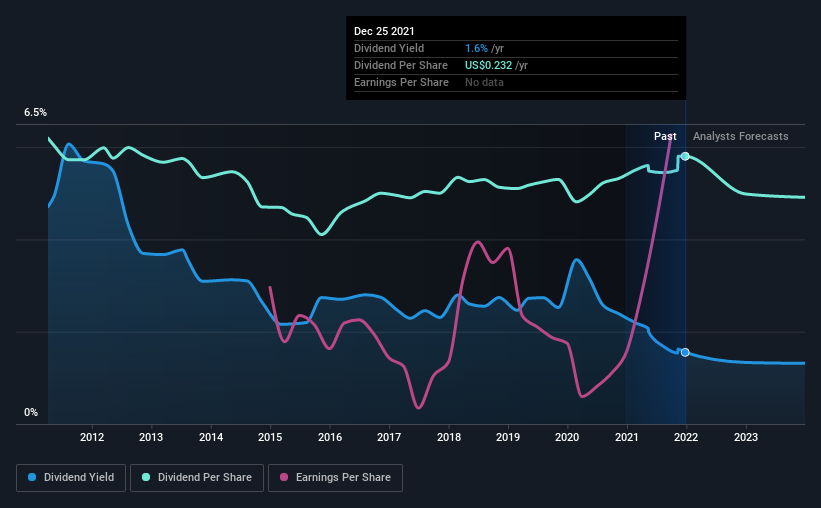There's A Lot To Like About Tricon Residential's (TSE:TCN) Upcoming US$0.058 Dividend
Tricon Residential Inc. (TSE:TCN) stock is about to trade ex-dividend in three days. Typically, the ex-dividend date is one business day before the record date which is the date on which a company determines the shareholders eligible to receive a dividend. The ex-dividend date is important because any transaction on a stock needs to have been settled before the record date in order to be eligible for a dividend. Therefore, if you purchase Tricon Residential's shares on or after the 30th of December, you won't be eligible to receive the dividend, when it is paid on the 17th of January.
The company's next dividend payment will be US$0.058 per share, on the back of last year when the company paid a total of US$0.22 to shareholders. Based on the last year's worth of payments, Tricon Residential has a trailing yield of 1.6% on the current stock price of CA$19.16. Dividends are an important source of income to many shareholders, but the health of the business is crucial to maintaining those dividends. As a result, readers should always check whether Tricon Residential has been able to grow its dividends, or if the dividend might be cut.
See our latest analysis for Tricon Residential
Dividends are typically paid from company earnings. If a company pays more in dividends than it earned in profit, then the dividend could be unsustainable. Tricon Residential paid out just 9.6% of its profit last year, which we think is conservatively low and leaves plenty of margin for unexpected circumstances. A useful secondary check can be to evaluate whether Tricon Residential generated enough free cash flow to afford its dividend. It distributed 41% of its free cash flow as dividends, a comfortable payout level for most companies.
It's positive to see that Tricon Residential's dividend is covered by both profits and cash flow, since this is generally a sign that the dividend is sustainable, and a lower payout ratio usually suggests a greater margin of safety before the dividend gets cut.
Click here to see the company's payout ratio, plus analyst estimates of its future dividends.
Have Earnings And Dividends Been Growing?
Stocks in companies that generate sustainable earnings growth often make the best dividend prospects, as it is easier to lift the dividend when earnings are rising. If earnings fall far enough, the company could be forced to cut its dividend. That's why it's comforting to see Tricon Residential's earnings have been skyrocketing, up 23% per annum for the past five years. Tricon Residential is paying out less than half its earnings and cash flow, while simultaneously growing earnings per share at a rapid clip. Companies with growing earnings and low payout ratios are often the best long-term dividend stocks, as the company can both grow its earnings and increase the percentage of earnings that it pays out, essentially multiplying the dividend.
We'd also point out that Tricon Residential issued a meaningful number of new shares in the past year. It's hard to grow dividends per share when a company keeps creating new shares.
Another key way to measure a company's dividend prospects is by measuring its historical rate of dividend growth. Tricon Residential's dividend payments per share have declined at 0.6% per year on average over the past 10 years, which is uninspiring.
The Bottom Line
Is Tricon Residential worth buying for its dividend? Tricon Residential has grown its earnings per share while simultaneously reinvesting in the business. Unfortunately it's cut the dividend at least once in the past 10 years, but the conservative payout ratio makes the current dividend look sustainable. Tricon Residential looks solid on this analysis overall, and we'd definitely consider investigating it more closely.
While it's tempting to invest in Tricon Residential for the dividends alone, you should always be mindful of the risks involved. We've identified 5 warning signs with Tricon Residential (at least 2 which are significant), and understanding these should be part of your investment process.
We wouldn't recommend just buying the first dividend stock you see, though. Here's a list of interesting dividend stocks with a greater than 2% yield and an upcoming dividend.
Have feedback on this article? Concerned about the content? Get in touch with us directly. Alternatively, email editorial-team (at) simplywallst.com.
This article by Simply Wall St is general in nature. We provide commentary based on historical data and analyst forecasts only using an unbiased methodology and our articles are not intended to be financial advice. It does not constitute a recommendation to buy or sell any stock, and does not take account of your objectives, or your financial situation. We aim to bring you long-term focused analysis driven by fundamental data. Note that our analysis may not factor in the latest price-sensitive company announcements or qualitative material. Simply Wall St has no position in any stocks mentioned.

 Yahoo Finance
Yahoo Finance 
